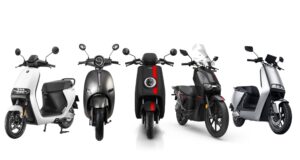Are you tired of your electric scooter running out of juice on longer rides? Do you want to extend the range of your trusty ride without breaking the bank? Look no further!
In this blog post, we’ll dive deep into electric scooter range extenders. From battery packs to solar panels, we’ll explore the pros and cons of each option so that you can make an informed decision about which solution is right for you. So buckle up (or hold on tight to those handlebars), and let’s get started!
What are Electric Scooters?
Electric scooters are a type of motorized scooter that runs on electricity instead of gasoline. They are becoming increasingly popular as an alternative to gas-powered scooters, as they are more environmentally friendly and often cheaper to operate. However, electric scooters typically have a shorter range than gas-powered ones, so riders need to be aware of this when choosing which type to purchase.
Two main types of electric scooters are those with a lead-acid battery and those with a lithium-ion battery. Lead acid batteries are cheaper, heavier, and less potent than lithium-ion batteries. Lithium-ion batteries are more expensive but lighter and more powerful, making them the better choice for most riders.
To extend the range of an electric scooter, riders can purchase a variety of range extenders. The most common type of range extender is a larger battery pack that can be attached to the scooter. Other range extenders include solar panels mounted on the scooter or towed behind it and generators used to recharge the battery while riding.
Range extenders can significantly increase the distance an electric scooter can travel on a single charge, but they come with some tradeoffs. Heavier range extenders can make the scooter more challenging to ride and maneuver, and solar panels can be pricey. Nonetheless, for riders who need extended range, investing in a good quality range extender is worth.
Overview of Range-Extending Options
There are many different ways to extend the range of your electric scooter. Some people use battery extenders, while others use range-extending wheels. Battery extenders are devices you can attach to your scooter’s battery pack to give it extra juice. Range-extending wheels are larger wheels with a motor, which helps push the scooter along.
Both of these options have their pros and cons. Battery extenders can be expensive and add a lot of weight to your scooter. Range-extending wheels can also be costly, making your scooter harder to maneuver.
If you’re looking for a cheap way to extend the range of your electric scooter, consider adding a battery pack. This will give you extra power when needed without adding too much weight or cost. Just be sure to get a high-quality bag from a reputable brand so that you know it will work well and last for a long time.
Pros and Cons of Battery Swapping
Three main types of electric scooter range extenders are battery swapping, charging stations, and solar panels. Each has its own pros and cons that you should consider before deciding which suits you.
Battery swapping is exchanging your scooter’s battery for a fully charged one at a designated station. The main advantage of this method is that it’s quick and convenient – you can swap out your battery in just a few minutes and be on your way. However, it can be expensive if you need to do it frequently, and it’s only sometimes available when you need it (especially if you’re far from a station).
Charging stations are usually located in public places like parking lots or gas stations, and they offer a slow but steady charge to your scooter’s battery. The benefit of this method is that it’s usually free or very cheap to use; the downside is that it can take several hours to get a full charge.
Solar panels are the most environmentally friendly option but also the least practical. They work best in sunny locations, so if you live in a cloudy area or use your scooter at night, they aren’t the best choice. They’re also more expensive than the other options.
Pros and Cons of Supercharging
There are three main types of electric scooter range extenders: battery packs, solar panels, and supercharging. Each has its pros and cons that you should consider before choosing one for your electric scooter.
Battery Packs
Pros:
-Easiest to install
-Inexpensive
-Can be used as a backup power source
-No emissions
Cons:
-Heavier than other options
-Must be regularly charged
-Limited range increase compared to other options
Solar Panels
Pros:
– renewable energy source
– can be used while riding
– emissions-free
Cons:
– must be installed on the scooter
– initial investment can be pricey
– needs direct sunlight to work well
Supercharging
Pros:
– Fastest charging time
– Can charge multiple scooters at once
– Increases range significantly
Cons:
– Expensive to install and maintain
– Emissions from the electricity grid
– Limited availability of stations
Pros and Cons of Solar Charging
When it comes to electric scooter range extenders, many different options are available on the market. One popular option is solar charging, which can be a great way to extend the range of your electric scooter. However, there are also some potential drawbacks to using solar charging. Below, we’ll examine the pros and cons of solar charging for electric scooters.
One of the most significant advantages of solar charging is that it’s a very eco-friendly option. Solar power is a renewable resource, so using it to charge your electric scooter helps reduce your carbon footprint. Solar charging can also be a great way to save money over time since you’ll eventually offset the cost of the initial investment with the money you save on your electric bill.
However, there are also some potential drawbacks to solar charging. One issue is that charging an electric scooter using solar power can take longer than it would with a standard charger. If you’re in a hurry or need to get somewhere quickly, there may be better options than solar charging. Additionally, solar chargers can be more expensive than traditional chargers, so you’ll need to weigh the upfront cost against the long-term savings before deciding.
Alternatives to Range Extenders
If you’re looking for an alternative to a range extender, you can try a few things. First, make sure that your scooter is properly inflated. This will help to reduce resistance and improve range.
Secondly, try riding in areas with less traffic. This will help to improve your scooter’s efficiency. Lastly, map out your route before riding to avoid any range-killing detours.
Conclusion
Electric scooter range extenders are a great way to increase the distance you can travel on your electric scooter. They come with pros and cons, so weighing these carefully before deciding is essential.
Consider factors such as the weight of the extender, its power output, and cost when choosing which one is right for you. With a little bit of research, you’ll be able to find an extender that suits your needs perfectly!



